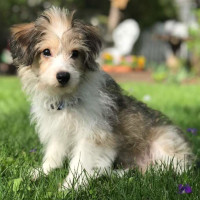 |
Shelchon |
|
He is not recognized by the F.C.I. |
Origin |
Great Britain <> France / Belgium -> U.S.A. | |
Translation |
Francis Vandersteen |
A brief presentation of the Shelchon |
| The Shelchon, also known as the Sheltie Bichon, is a medium-sized hybrid breed created by crossing a pure-bred Shetland Sheepdog with a pure-bred Bichon frise. The most common colors are white, brown, tan, cream, black and sable, and their coat is medium to long, thick and double-coated. Their coat can be soft and slightly wavy. The Shelchon is a gentle, cheerful dog that makes a very affectionate family pet. He's great with children but tends to be a little cautious around strangers. They are curious and energetic, but can be prone to excessive barking. They also have a strong herding instinct and may try to herd smaller dogs and cats, and have been known to bite. They shed quite a lot and require a fair amount of grooming. |
History of the Shelchon |
| The Shelchon is a hybrid breed, a cross between a pure-bred Shetland Sheepdog and a pure-bred Bichon frise. |
A little of the Shetland Sheepdog |
||
| Bred as guard dogs for farmers in the Shetland Islands off the coast of Scotland, these dogs also kept birds away from their small sheep. The Shetland Islands are also home to other small breeds of animal, such as Shetland ponies. Shetland Sheepdogs, nicknamed Shelties, resemble small Rough Collies, but are a different breed. Some of their ancestors are said to be King Charles Spaniel and Pomeranian. The first dogs were called “Toonie”, meaning “farm dogs”. Some were taken to the UK, where early breeders crossed them with wire-haired Collies. Initially, they were also called Shetland Collies, but this name was dropped following objections from Collie breeders. The American Kennel Club recognized the Shetland Sheepdog in 1911. | ||
 |
||
| Standard of the Shetland Sheepdog |
A little of the Bichon frise |
| The Bichon frise was developed on the Mediterranean island of Malta, and is related to the Coton de Tuléar, the Bolognese Bichon, the Havanese Bichon and the Maltese Bichon. The Barbet, a woolly water dog, is thought to be one of the Bichon's ancestors. Some say that the word bichon comes from “barbichon”, a diminutive of the word barbet. Documents dating from the 14th century suggest that French sailors brought these dogs back from Tenerife, one of the Canary Islands. These cute little dogs were also popular in Spain, appearing in paintings by Goya. Later, they fell out of favor with royalty and were used as performers in circuses, where their charming personalities captivated audiences. The official breed standard was adopted in France in 1933. The Bichon frise was introduced to the United States in 1956, and the Bichon Frise Club of America was recognized by the American Kennel Club in 1975. |
 |
| Standard of the Bichon frise |
Appearance of the Shelchon |
| The Shelchon is a medium-sized hybrid breed with a rounded head and blunt muzzle. It is a cross between a pure-bred Shetland Sheepdog and a pure-bred Bichon frise. It adopts the appearance and characteristics of both parent breeds. The most common colors are white, brown, tan, cream, black and sable, and the coat is double thick and medium to long in length. Their coat can be soft and slightly wavy, like that of a Bichon frise. The Shelchon has round, dark brown eyes with an alert, curious expression, and a black nose. |
Temperament of the Shelchon |
| The Shelchon is a highly intelligent, good-tempered and charming dog. They are affectionate pets and are happiest when surrounded by family members. They hate being alone and can become destructive if left alone for long periods. They make good playmates for children, but are a little wary of strangers. They'll bark if they see a stranger, so they make good watchdogs and can be very protective even if they're not very big. Early training and socialization will help them get used to the other animals in the house, as they have a strong herding instinct and are known to bark or bite when excited. For the most part, they are affectionate, playful dogs who are easy to train. Their intelligence enables them to assimilate commands easily, and positive reinforcement is the best way to train them. They are curious, energetic dogs that are well suited to new dog owners. |
Needs and activities of the Shelchon |
| The Shelchon is an energetic dog that loves to run and thrives on activities like flyball or Frisbee. He'll enjoy walks at the dog park or beach, but must be kept on a leash as he has a strong hunting and herding instinct. These dogs need plenty of mental and physical exercise to prevent them from becoming bored and developing destructive behavior and excessive barking. They love to play, whether indoors or out. They can adapt to life in an apartment, provided they are taken out every day. They're not overly concerned about the weather and will be happy in winter or summer, but don't exercise your dog in the heat. |
Maintenance of the Shelchon |
| The Shelchon tends to shed a lot, so it needs weekly brushing to remove loose hair. They tend to shed more at certain times of the year, and should be brushed daily. This breed is prone to allergies, so good grooming habits are important. They will need trimming from time to time, which may be easier at a professional groomer. These dogs don't need to be bathed too often, and should be dried thoroughly afterwards. If they resemble the Bichon frise, they may develop tear stains which can be cleaned. Ears should also be checked for dirt, and teeth should be brushed daily. Nails should be trimmed if too long. |






 English (United Kingdom)
English (United Kingdom)